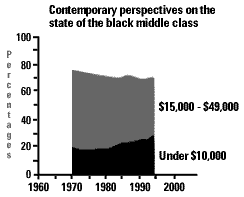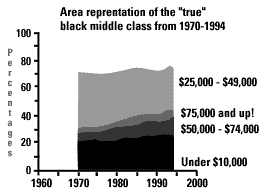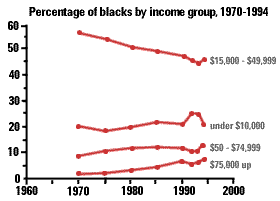|
The major question to be considered is whether or not the Black community is
economically better off than we were in 1965.Like most questions, the answer
depends upon your perspective.

Contemporary perspectives on the state of the Black middle class are
misleading. It is commonly held that:
* The Black middle class is not only larger than ever, but that it is the fastest growing and largest segment within the
Black community.
* The Black middle class has doubled and even quadrupled since
1965.
* The Black middle classes are doing better than they were in 1965.
Data collected by the U.S. Census Bureau provide a different interpretation.
1. Problems with current interpretations of the data:
* There is no standard definition of the Black middle class.
Most define it as families with annual incomes (before taxes) between $15,000
and $49,999. This puts the number of Black families at 13.3 million or 46.7% of
all Black families in 1994.
I believe a more accurate definition of the Black middle class places the
income range between $25,000 and $49,999. I say this because the poverty line
for a family of four, in 1995, was $15,569 ($15,141 in 1994). It seems
disingenuous to categorize those making slightly more than the poverty line as
members of the Black middle class. Using this income range puts the number of
Black families in the middle class at 9 million or 31.9% of all Black families
in 1994. (Keep in mind that 32.3% of all Black families earned incomes below
the poverty line during the same period - 1994).
This is clearly the largest segment of the Black population, as the graph below
illustrates:

However, is the Black middle class ($25,000 - $49,999) the fastest
growing segment of the Black population?
The answer is NO.
Dividing the Black population into quintiles (20% intervals), the fourth 5th
and the highest 5th are the fasting growing segments. That is, the upper
class , has experienced the fastest rate of growth since 1965.

From the graph above, it is clear that not only is the Black middle class
(using the misleading income range just to be sure) not the fastest growing
segment, it has been steadily declining since 1970.
* Evenusing the misleading income range of $15,000 - $49,999,
the percentage of Black families within this bracket in 1970 was 56.3% or
11,667,612 people. But, in 1994, the percentage had declined to 46.7% or
13,309,033 people; a decline of 9.6%!
* On the other hand, those families making between $50,000 and $74,999 saw an
increase of 3.9% over the period from 1970 and 1994.
Those families earning $75,000 and above saw an increase of 5.7% over the
period from 1970 to 1994.
The true winners have been those classified (even as far back as 1970) as the
upper class. The percentage of the Black population in the middle class is
shrinking.
So, how can we claim that the Black middle class has doubled?
* The only plausible explanation I can find is that those who make such claims
are looking only at the sheer numbers of black families earning between $15,000
and $74,999.
But using sheer numbers, the "true" Black middle class has NOT
doubled. In 1970, the number of families earning between $15,000 and $49,999
reached 11,667,612. In 1990, the number grew to 13,309,033; hardly a
doubling!
What's more, there has been a squeezing effect: the middle class present in
1970 has been squeezed over a 20 year period, pushing families above and below
the middle class lines. The promising news is that more families have been
pushed upward, but we have not filled their places with families from the lower
classes.
|